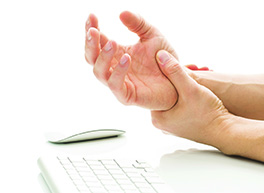Chronic Pain
Triangular Fibrocartilage Complex Injuries – The Wrist
 A wrist and hand injury can have a large impact on our ability to complete activities of daily living, as well as work commitments and hobbies, meaning that appropriate rehabilitation is really important for the long-term ability to participate in these activities!
A wrist and hand injury can have a large impact on our ability to complete activities of daily living, as well as work commitments and hobbies, meaning that appropriate rehabilitation is really important for the long-term ability to participate in these activities!
What is the TFCC?
The TFCC is a ligamentous and cartilaginous structure in the wrist that is very important in supporting the bony structures when bearing load. It is really important in supporting the forearm bones (radius and ulna), when grasping or rotating the arm. Injury to this structure can result in chronic pain or instability.
Causes:
- Falling on an outstretched hand
- Excessive arm rotation (forced, or fall on an already rotated arm)
- Overuse (degenerative tears can occur in older people)
Symptoms:
- Pain at the base of the pinky finger
- Pain worsens as the wrist is bent from side to side
- Swelling
- Painful clicking with movement
- Loss of grip strength
- Inability to weight-bear through the affected upper limb
Diagnosis most often occurs through careful examination of the wrist, but the gold standard for a diagnosis is an MRI. Often, patients may be referred for imaging to rule out fractures or other more serious injuries.
Treatment
Treatment of a TFCC injury can vary quite significantly depending on the injury.
Conservative management:
Initially, conservative management includes a period of rest and de-loading to allow for tissue healing. This is often achieved via splinting for 3-6 weeks dependent on the severity of the injury. After tissue healing has occurred, rehabilitation is required to work on regaining range of motion and strength, to return to activities of daily living, manage pain and prevent recurrence of injury. Exercises will include general mobility exercises as well as strengthening exercises.
Exercises may include:
- Isometrics (static holds in pronation, extension and ulnar deviation)
- Pronation/supination with dumbbell (forearm rotation strength)
- Wall-push up (helps to strengthen load tolerance)
- Grip strength exercises
Surgical management:
Sometimes, for a highly severe injury, surgery is required to ensure stability in the joint. This may result in several weeks of immobilisation whilst the tissues are healing, and then an extensive rehab program to ensure strength and range of motion is re-gained. Rehabilitation may be overseen by a general physiotherapist or a specialist physiotherapist of the hand/wrist.
References:
https://www.rushortho.com/body-part/wrist/triangular-fibrocartilage-complex-tear#:~:text=Falling%20on%20an%20outstretched%20hand,the%20cartilage%20down%20over%20time.
https://www.summitmedicalgroup.com/library/adult_health/sma_triangular_fibrocartilage_complex_injuries_exercises/
